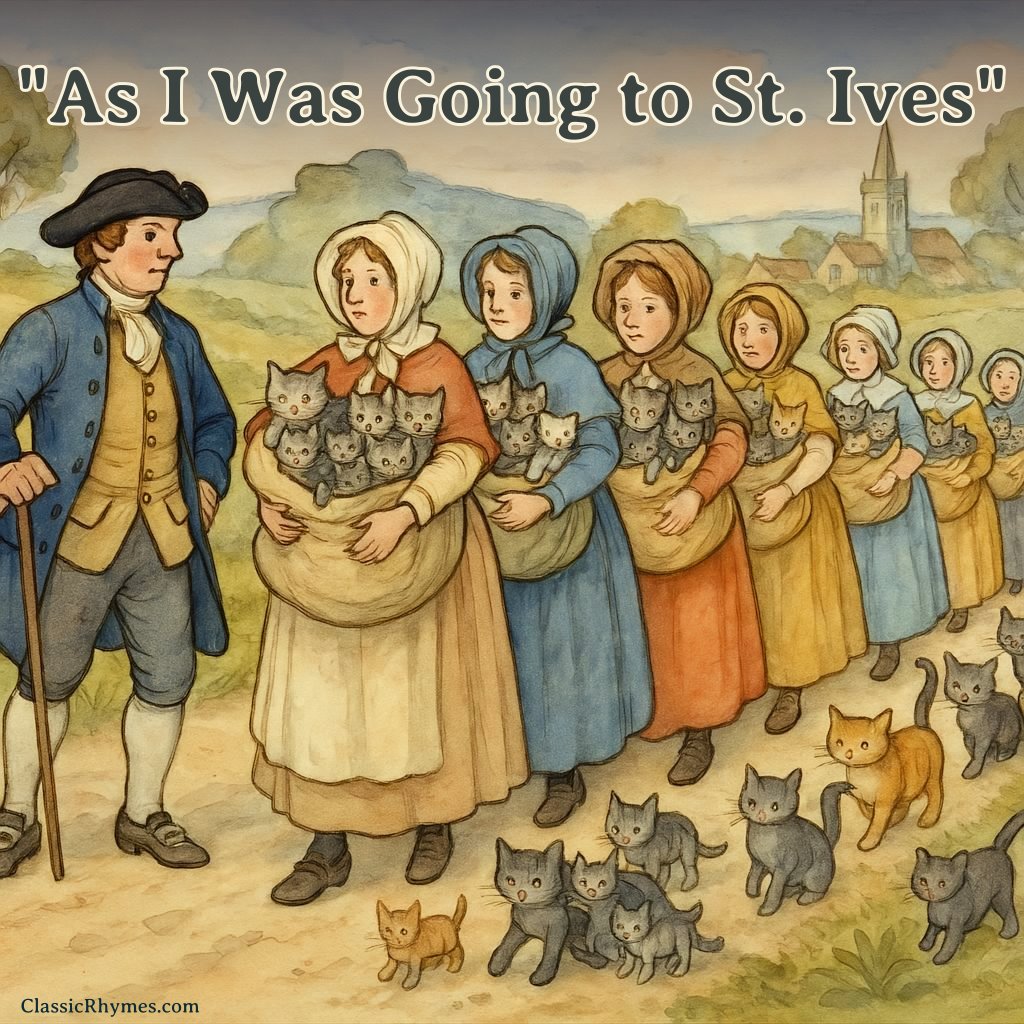As I Was Going to St. Ives
The rhyme “As I Was Going to St. Ives” is a classic riddle that presents a playful math problem involving a man, his wives, sacks, cats, and kittens. This article explores the riddle’s meaning, the trick behind its answer, and its enduring appeal in popular culture.
As I was going to St. Ives,
I met a man with seven wives.
Each wife had seven sacks,
Each sack had seven cats,
Each cat had seven kits.
Kits, cats, sacks, and wives,
How many were going to St. Ives?
This rhyme is a riddle
Can you tell me how many people were going to St. Ives?
Show Answer
The answer to the riddle is a bit of a conundrum. Let’s break it down:
- 1 Man
- 7 Wives
- 343 cats
- 2,401 kits (kittens)
That is a total of 2,801 and there was only 1 man.
The answer to the riddle is used to help improve logical thinking in children… and adults!
Since he met them whilst he was going to St. Ives, they were going the other way.
Only 1 man was going to St. Ives!
Good job!
Print or Save This Rhyme
Download PDFRecitals
Listen as male American:
Listen as female British:
Listen as told in a story:
What is the Meaning of the ‘As I Was Going to St. Ives’ Nursery Rhyme?
This rhyme is a classic riddle that encourages logical thinking and careful listening. While the listener might be tempted to tally up all the kits, cats, sacks, and wives (yielding a very large total), the correct answer is generally considered to be “one”—the narrator—since the others were simply encountered on the road and not stated to be going to St. Ives.
History and Origin of the Rhyme
The earliest written versions date to around 1730, appearing in British manuscripts and later published as a riddle in the late 18th century. The rhyme references the real town(s) of St Ives in Cornwall or Cambridgeshire, England, both plausible destinations in nursery rhyme history.
Time Period
First documented in the early 18th century, with popularization through oral tradition and print throughout the Victorian era. It remains a common classroom and parlor riddle today.
Historical or Cultural Notes
The rhyme draws on centuries-old English poetic and logical tradition, and references multiple real locations called St Ives, both market town and port. Its unique cumulative challenge makes it a classic riddle rhyme.
Why It Became Popular
Its mathematical structure, memorable cadence, and riddle formulation make it ideal for educational settings and family entertainment. It encourages listeners to solve problems and think critically.
Notable Variants
Earlier versions may use “nine wives” (not seven) or feature different animals/bags, but preserve the trick answer at the end.
Structure, Style, and Themes
Structure and Style
- Meter: Rhythmic, suitable for recitation
- Rhyme Scheme: Typically AABCCB
- Line Count: Seven lines (riddle version)
- Style Notes: Riddle rhyme, narrative, cumulative structure
Themes
- Logic and careful listening
- Problem solving
- Riddles and oral tradition
- English geography and travel
Language Notes
Uses repetition and accumulation to encourage tallying and mental calculation. The language is simple but designed to mislead and provoke analysis.
Moral or Lesson
Promotes analysis and attention to detail, showing that careful listening often precedes good problem-solving.

